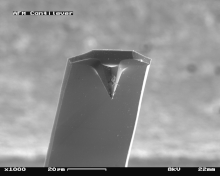microscope

A microscope ( Greek μικρός mikrós "small"; σκοπεῖν skopeín "to look at") is a device that allows objects to be viewed or represented in a highly enlarged manner. These are mostly objects or the structure of objects whose size is below the resolution of the human eye . One technique that uses a microscope is called microscopy . Microscopes are an important tool in biology , medicine and materials science . The physical principles that are used for the magnification effect can be very different in nature. This article gives an overview of the different microscope types, all of which are also presented in separate articles. The best known types are light microscopes , electron microscopes and scanning probe microscopy .
history
The oldest known microscopy technique is light microscopy, which was probably developed in the Netherlands around 1600. With her, an object is observed through glass lenses . At the beginning of the 17th century, the microscope, equipped with an objective and an eyepiece, was named after the word "telescope". The physically maximum possible resolution of a classic light microscope depends on the wavelength of the light used and is limited to around 0.2 micrometers at best . This limit is called the Abbe limit because the underlying laws were described by Ernst Abbe at the end of the 19th century . However, some methods are now known with which this limit can be overcome.
Electron microscopes , which have been developed since the 1930s, enable higher resolution because electron beams have a smaller wavelength than light. Atomic force microscopes work on a different principle and have very fine needles with which the surface of objects is scanned. More types are listed below.
Imaging and scanning microscopy
Classic types of light microscopes are based on an imaging principle: Similar to photography, an image is created in the device through a series of lenses that is seen or recorded in one piece.
Some light microscopic methods and especially microscopes based on other physical principles, on the other hand, rely on scanning the object, in which the individual points of the enlarged image are generated one after the other, line by line. These include, for example, laser scanning microscopes , electron microscopes and atomic force microscopes.
Microscopy method based on the physical principle
Light microscopes , electron microscopes and scanning probe microscopes are built and used in numerous variants, which are presented in the respective overview articles. In addition to these, there are also microscopes that are based on other physical principles:
- Electrochemical scanning microscopy
- Focused Ion Beam Microscope (FIB)
- photonic force microscope
- Helium ion microscope
- Magnetic resonance microscope
- Neutron microscope
- Scanning SQUID microscope
- X-ray microscope
- Ultrasonic microscope or acoustic microscope
literature
- Olaf Breidbach : microscopy. In: Werner E. Gerabek , Bernhard D. Haage, Gundolf Keil , Wolfgang Wegner (eds.): Enzyklopädie Medizingeschichte. De Gruyter, Berlin / New York 2005, ISBN 3-11-015714-4 , p. 989 f.
- Marian Fournier: The Fabric of Life. Microscopy in the Seventeenth Century. Johns Hopkins University Press, Baltimore and London 1996. ISBN 0-8018-5138-6 .
- Dieter Gerlach: History of microscopy , Harri Deutsch, Frankfurt am Main 2009. ISBN 978-3-8171-1781-9 .
- Simon Rebohm: Early Microscopy , Edition Open Access 2017, Online
Web links
Individual evidence
- ^ Rainer Brömer: Histology. In: Werner E. Gerabek et al. (Ed.): Enzyklopädie Medizingeschichte. 2005, p. 605 f .; here: p. 605.

